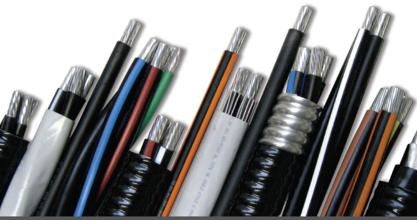Company
How to Examine the Aluminum Alloy Cable
Posted: 2015-10-22 19:33:15 Hits: 1648
This article introduces several tips on how to examine the aluminum alloy cables in detail.
1. Core pressure coefficient
There are some differences between aluminum alloy cable and conventional power cable, including the process structure and auxiliary materials. The aluminum cable applies monofilament pressed method and the core pressure coefficient can reach to 97%, the conductor is very dense. It can be distinguished from the cross section, for the conventional power cable, its core pressure coefficient can only reaches to 82% or so.
2. Flexibility
The aluminum cable is used ASTM-B800 8000 series aluminum alloy, and added the appropriate amount of cooper, iron and magnesium, gives the conductor more flexibility. The excellent flexibility ensures more security than copper cable in application, and brings more advantages in installment. Tests show that generally, it need 18 times folding that can crack or break the aluminum alloy cable, while the ordinary cable is very easy to be distorted only through three or five times of folding. Another drawback of ordinary cable is its fragility. During the installment, if the cable is twisted, then the conductor may have cracks, and cracks will be heat and corroded, this is an important reason to result in fire, and also is reason why the ordinary cable can not be popularized.
3. Structure of cable
The core of aluminum alloy cable is applied pressed method; this cross section is circular, compared with the sectorial of conventional one. The insulation is applied three color polyethylene insulation technology, the core has certain arrangement, and the cable is round and flexible.
4. Luster of core
During the smelting, the rare earth has been added, therefore, the cross section of aluminum alloy cable looks brighter, and there is an obvious sensory difference to the traditional one.
5. The creep property
The creep property is almost the same between alloy conductor and copper conductor. Tests show that the yield strength of copper is 6.0; the alloy conductor is 54, basically the same with copper conductor, 300 times than aluminum conductor.
6. Elongation
Elongation is an important indicator of the mechanical properties of conductor, also is a major symbol of quality and withstand force. After annealing treatment, the elongation of aluminum alloy cable can reaches more than 30%, the cooper cable can achieves 30%, while the ordinary cable only have 15%.
7. Tensile strength
The density of aluminum is only 30.4% of copper conductors, thus, in the context of the same electrical properties, the cross section can up to 150% of copper conductor. The weight of aluminum conductor is only 45% of copper conductor, which gives aluminum alloy conductor higher tensile strength than copper one. Because of these advantages, in large scale programs, the tensile strength of aluminum alloy cable is particularly prominent. Not only save a lot of bridge, reduce labor intensity, but also accelerate the installation process, saving the period and greatly reduce the overall cost of installation.
8. Anti-corrosion
Aluminum conductor has excellent corrosion resistance; this is from the inherent anti-corrosion of aluminum. When the aluminum is exposed to the air, a dense oxide film of thickness of about 2 to 4μm will be formed immediately. The oxide film can withstand the harshest surroundings, thus its service life is 10 years longer than copper cables.

